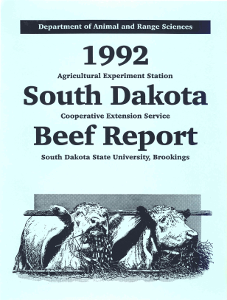Document Type
Report
Report Number
92-9
Publication Date
1992
Keywords
calves, monensin, coccidiosis
Summary
This research addressed the effects of dietary monensin on the performance and health of steer calves weaned and shipped directly to the feedlot. Feedlot receiving diets were based on corn silage and contained 0, 10, 20, or 30 g/ton monensin. Calves were allowed ad libitum access to feed for 85 days to determine the effects of monensin level on dry matter intake, average daily gain, and fecal shedding of coccidia oocysts. Higher levels of monensin caused decreases (P<.05) in dry matter intake during the initial feeding period. Gains were not affected by monensin during this period and as a result feed efficiency was improved (P<.05) when diets contained 20 or 30 g of monensin per ton. Cumulative 85-day feedlot performance was not affected by treatment. Over 90% of all calves were shedding coccidia oocyst when they arrived in the feedlot. The number of calves shedding oocysts was consistently reduced by monensin after 18 days postweaning.
Number of Pages
5
Format
application/pdf
Language
en
Publisher
South Dakota State University
Rights
Copyright © 1992 South Dakota State University.
Recommended Citation
Pritchard, R. H. and Thomson, J. U., "Optimum Monensin Levels in Receiving Diets for Newly Weaned Calves" (1992). South Dakota Beef Report, 1992. 10.
https://openprairie.sdstate.edu/sd_beefreport_1992/10


